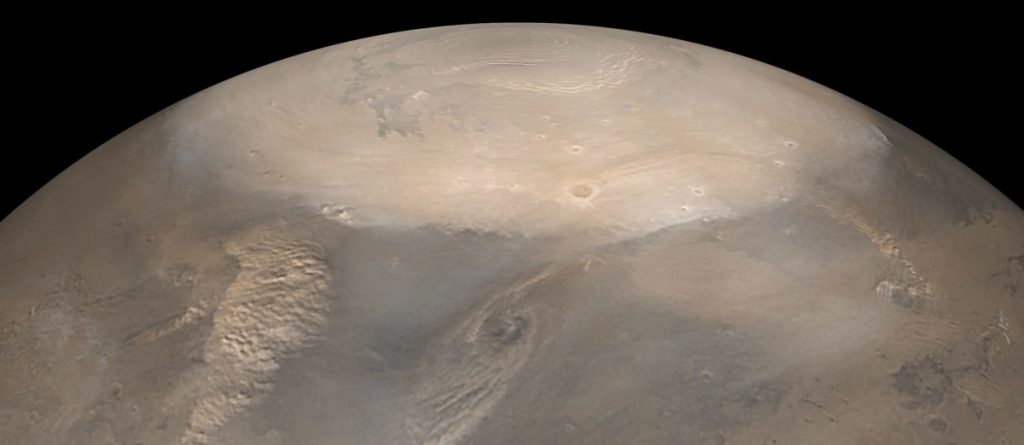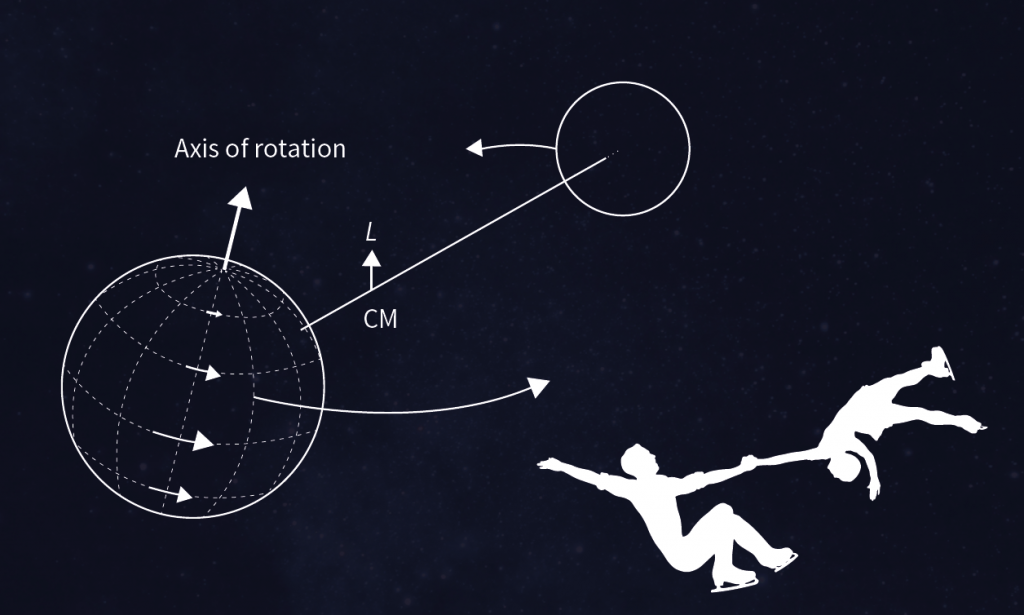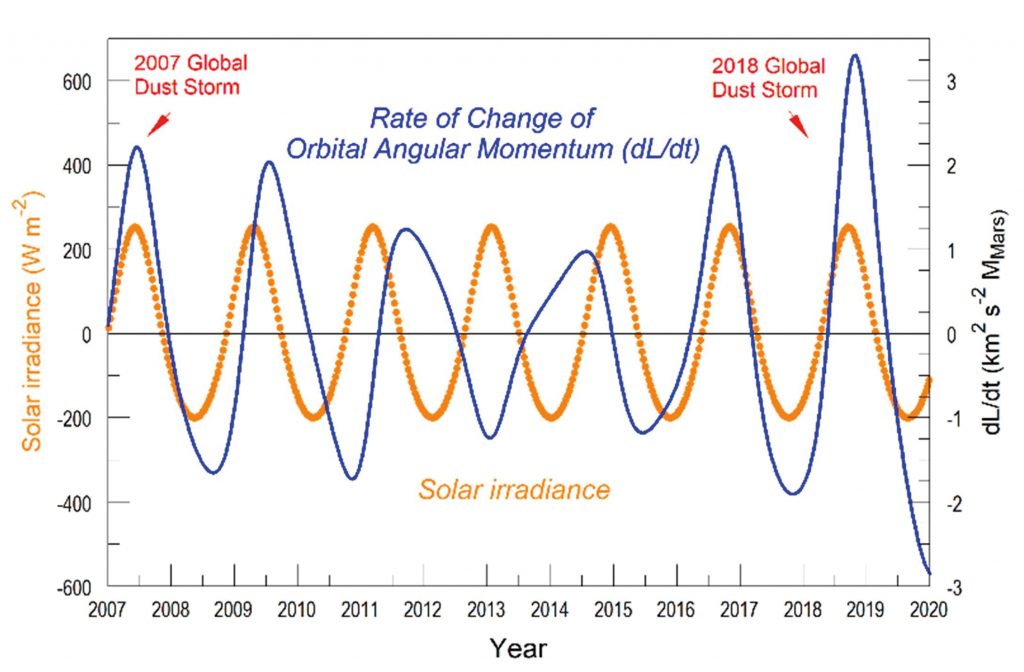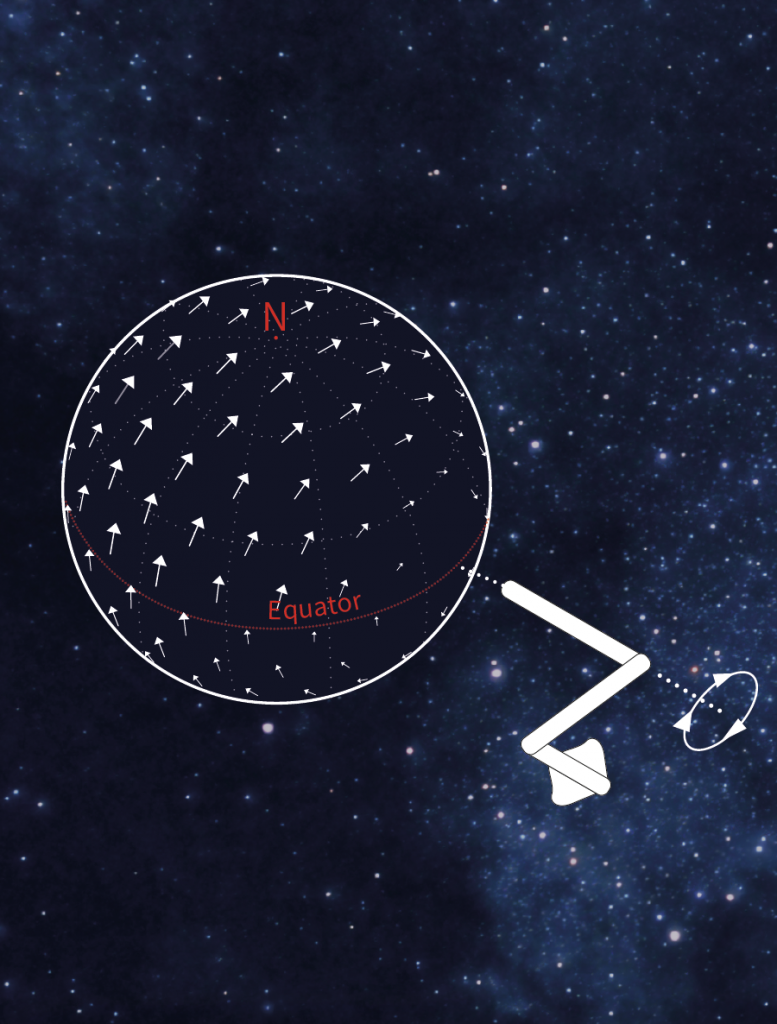James H. Shirley – Uncovering the Trigger for Mars’ Global Dust Storms
Enshrouding the Martian surface with thick clouds of dust, the Red Planet’s unique global dust storms have long mystified astronomers and planetary scientists. James Shirley, at NASA’s Jet Propulsion Laboratory, has shown through his research that the occurrence of these global storms is strongly linked to the changes in Mars’ motion about the gravitational centre of the solar system. Already boasting strong observational evidence, his results could not only improve our understanding of the Mars atmosphere – they may also lead to a better understanding of turbulent weather patterns on Earth.
Dust Storms
Every summer in Mars’ southern hemisphere, large dust storms are stirred up from the planet’s surface, producing striking clouds which can be clearly seen, both in satellite images, and in telescopic images obtained on Earth. The strong seasonal pattern in the timing of these storms is due to the elliptical shape of Mars’ orbit, varying its distance from the Sun.
Mars reaches its closest point to the Sun during the late spring season of its southern hemisphere. This results in higher temperatures, and increasing surface winds, allowing dust to be kicked off the surface more readily. Yet every few years, this process appears to go into overdrive: in 2018, Mars experienced a dust storm so ferocious that it enshrouded the entire planet. For several weeks, the dust cloud was so thick that many of the known features and landmarks on the planet’s surface were completely obscured. These dramatic events have now captured the public imagination, producing the terrifying clouds that first stranded Mark Watney in Ridley Scott’s The Martian.
The mystery as to why these global storms appear in some years, but not in most others, has puzzled astronomers and planetary scientists for decades. According to Shirley, however, the timing of the global storms can now be explained by a novel mechanism known as orbit-spin coupling.

Figure 1. Regional dust storms sweep eastward (from left to right) around Mars’ growing northern polar cap region during the southern summer dust storm season. CREDIT: NASA PIA 10787.
Dragged Along By the Sun
When we think of the Solar System, we typically imagine the Sun in a fixed position at its centre, unaffected by the gravitational pull of its vastly smaller orbiting planets. However, this picture isn’t entirely accurate. In reality, the Sun noticeably shifts away from the gravitational centre of the Solar System due to the influence of the heavy gas giants, particularly Jupiter and Saturn. The motions of these bodies cause the Sun to orbit around a centre of mass which can be hundreds of thousands of kilometres away from its own centre – this ‘barycentric revolution’ is not unlike the motion of a pair of dancers spinning while holding hands, as shown by Figure 2.
The smaller inner planets, including Earth and Mars, are dragged along in this dance by their gravitational attraction to the Sun. One result is to significantly alter the ‘orbital angular momentum’ (OAM) of Earth and Mars. The OAM is the product of the planets’ masses, velocities, and orbital distances from the centre of the solar system. Its magnitude can be thought of as the amount of momentum that would need to be removed in order to somehow stop their orbital motions in their tracks.
Depending on the relative positions of the giant planets, which throw the Sun out to varying distances from the Solar System’s centre, Earth and Mars can either lose or gain OAM, while the total angular momentum of the solar system remains constant. Figure 3 shows the changes in the angular momentum of Mars between the years 2006 and 2020, alongside the solar energy received by Mars.
The orbital momentum of Mars is millions of times larger than the angular momentum associated with its spin. The angular momentum of the atmospheric circulation, by comparison, is an additional ten million times smaller still.
Until now, the ongoing changes in OAM have been largely ignored, both by astronomers and by atmospheric scientists – since, under existing theories, they don’t appear to have any significant influence on important factors such as the planetary surface temperature. In contrast, Shirley’s work demonstrates that OAM changes are key to understanding why global dust storms arise on Mars in certain years, but not others. The underlying mechanism is simple in concept: A tiny fraction of the OAM is transferred, more or less continuously, to (and from) the planetary rotation, as the OAM changes with time (Figure 3). The planetary atmosphere participates in the transfer of momentum between the two.

Figure 2. Two bodies orbit a shared centre of mass.
Nature of the Coupling
While scientists have long suspected that a connection might exist between orbital motions and rotational motions, no theory existed to explain how that connection might be accomplished. Through his earlier research, Shirley was the first to derive an equation describing how the orbital momentum could be ‘coupled’ to the vector describing the rate at which Mars spins on its axis – which is tilted at an angle relative to its orbital plane.
Shirley’s orbit-spin coupling equation yields an acceleration field that is illustrated in Figure 4. The arrow symbols on the figure give the directions and relative sizes of the horizontal forces that result from the coupling. This fixed pattern of forces takes the appearance of a beach ball, with the forces acting in directions which appear at first glance to bear no relation to Mars’ rotation or orbital motion. We have to imagine the planet spinning through, or beneath, this pattern of forces, as it rotates in a counter-clockwise direction around the north pole, shown near the top of the figure.
The large-scale pattern of the forces on the planet provides a twisting effect, or torque, about an axis lying within the equatorial plane of the body, as indicated by the cartoon shown at the lower right in Figure 4.
In Figure 3, we see that the curve giving the changes of Mars’ OAM often passes through zero. When this happens, the force vectors shown in Figure 4 diminish and disappear, to re-emerge thereafter pointing in opposite directions. Orbit-spin coupling thus produces a reversing torque that varies in a complex manner with time. This turns out to play an important role in the triggering of global dust storms.
As they act on the Martian atmosphere, the predicted forces must accelerate its air to widely varying degrees. Prior to Shirley’s investiagtions, the atmospheric motions produced by orbit-spin coupling had never been considered – but this was soon about to change.
Effects on the Large-scale Circulation
As with the Earth, the circulation of the atmosphere on Mars is primarily driven by energy arriving from the Sun.
Several well-known effects control the large-scale pattern of the circulation. For instance, as air is heated at the planet’s equator, it rises to high altitudes, and moves to higher latitudes in the upper atmosphere. After the air cools, it then drops back down to the surface, and moves back to the equator across Mars’ surface, producing two separate circulation loops known as Hadley cells. Another important control is provided by the well-known Coriolis force, which causes high-pressure systems to circulate in a clockwise direction in the northern hemisphere, and counter-clockwise in the south – with important consequences for global weather patterns. The atmospheric motions induced by orbit-spin coupling are superimposed on these larger patterns.
Shirley’s work with atmospheric circulation computer models shows that as Mars spins beneath the approximately fixed beach ball pattern of forces (Figure 4), the atmosphere above individual points on its surface will be pushed around, and pressure systems will be pushed out of shape, by continually varying forces throughout the day. While the added atmospheric forcing due to the coupling could be pushing weather systems northwards in the morning, the push could weaken and stop by the afternoon; before strengthening in the opposite direction, and pushing the weather southward in the evening.These effects might not be be particularly important, under typical circumstances. However, the situation changes entirely if the time when Mars is gaining OAM most rapidly happens to coincide with the dust storm season – the time when the planet reaches its closest point to the Sun. If these two events happen within a few months of each other, computer models show that exceptionally strong motions within the atmosphere may kick dust off the Martian surface even more vigorously than normal. Figure 3 illustrates this correspondence for the two most recent Martian global dust storms, which occurred in 2007 and in 2018. At these times, Mars was rapidly gaining OAM, at the expense of other planets.
Shirley’s studies of atmospheric general circulation models confirm this relationship. When Mars is gaining OAM from the Sun, the global wind patterns favourable for dust storm occurrence can be strengthened by 20% or more. Atmospheric computer models lacking the orbit-spin coupling accelerations, by comparison, show no such variability.

Figure 3. The curve in blue illustrates times when Mars is gaining and losing orbital angular momentum. Orange symbols indicate the period of the Mars year.
How Strong is the Evidence?
Scientists generally require strong statistical evidence before lending credence to new ideas. Several scientific papers published since 2015 have reported statistically significant relationships and patterns linking changes in Mars’ OAM with dust storms. The next step in proving a new hypothesis involves detailed numerical calculations and modelling studies, which can demonstrate that the theoretical mechanism is strong enough to produce important effects. This milestone was passed in Shirley’s 2017 paper, which presented the orbit-spin coupling equation for the first time.
Computer modelling with atmospheric general circulation models, while expensive, allows more powerful testing to be done. Two recent studies revealed that models including orbit-spin coupling could produce conditions favorable for dust storm occurrence in the years in which such storms actually occurred. They could also reproduce the century-long historic record of Mars years with and without global dust storms, with an accuracy approaching 80%. No other model has approached this success rate, either for Mars, or for the Earth. All of the global dust storms of the historic record have occurred either when the magnitude of the torque was peaking, or when the torques were changing most rapidly, as in 2018.
The orbit-spin coupling hypothesis was employed to successfully forecast the 2018 global dust storm on Mars, in a series of scientific papers beginning in 2015. Even more convincingly, the predicted circulation changes were confirmed through direct observations of the Mars atmosphere by spacecraft in the earliest days of the 2018 storm. Shirley’s models predicted that the spinning-up of the atmosphere in that season would lift dust tens of kilometres higher into the atmosphere than would be the case for typical summer storms.
The expected powering-up of the large scale circulation was actually observed, between June 4 and June 9.
As the high-altitude dust fell and spread out, it was then carried large distances by high-altitude winds, enshrouding the entire planet within just a few days. The orbit-spin coupling hypothesis thus successfully explained both the mechanism for strong dust lifting and the patterns seen in the timing of global dust storm occurrence.

Figure 4. The pattern of horizontal forces produced on a planetary surface by the coupling of the orbital and rotational motions. The turning tendency, or torque, produced by the forces shown is indicated by the bicycle pedal assembly shown as a cartoon at the lower right.
Forecasting Future Events
The orbit-spin coupling approach has enabled Shirley and his co-workers to forecast when future global storms are likely to occur. He expects that the next such storm will most likely occur in 2026, following a relatively quiet period of Martian weather.
Ultimately, his research strongly indicates that existing atmospheric general circulation models must be updated to account for this new effect, which has long escaped the attention of climate modelers. Orbit-spin coupling has already significantly improved our understanding of how the Martian atmosphere behaves; its forecasts may even help future settlers of the Red Planet to avoid the fate that befell Mark Watney.
Studying Our Home Planet
While it is fascinating to study atmospheric behaviours on Mars, Jim Shirley’s work is ultimately directed towards a more important goal: improving atmospheric general circulation models for Earth. Currently, even the most advanced models cannot forecast the intricate variability in Earth’s weather patterns beyond around two weeks in advance, leaving communities with little time to prepare for damaging storms.
While Earth’s atmosphere and surface are more complex, with features not found on Mars, such as oceans and forests, producing complex alterations in its atmospheric circulation, Shirley is convinced that the influence of orbit-spin coupling still plays a fundamental role.
By accounting for how changes in Earth’s orbital angular momentum induce continually varying levels of atmospheric forcing, researchers could conceivably make far better predictions of when and where the most damaging weather events could occur. In a changing climate, such predictions could prove critical for saving lives in natural disasters, and for protecting the economic wellbeing of many millions of people around the world.
Reference
https://doi.org/10.33548/SCIENTIA635
Meet the researcher

James H. Shirley
California Institute of Technology – Jet Propulsion Laboratory (retired)
CONTACT
E: jrocksci@att.net
FURTHER READING
JH Shirley, A Kleinböhl, DM Kass, Orbit-spin coupling torques and Martian dust storm activity in MY 34 and MY 35, https://www.essoar.org /doi/abs/10.1002/essoar.10505174.1 (open access).
MA Mischna, JH Shirley, Numerical Modeling of Orbit-Spin Coupling Accelerations in a Mars General Circulation Model: Implications for Global Dust Storm Activity, Planetary and Space Science, 2017, 141, 45–72.
JH Shirley, Orbit-spin coupling and the circulation of the Martian atmosphere, Planetary and Space Science, 2017, 141, 1–16.
JH Shirley, CE Newman, MA Mischna, MI Richardson, Replication of the historic record of Martian global dust storm occurrence in an atmospheric general circulation model, Icarus, 2019, 317, 192–208.
JH Shirley, A Kleinböhl, DM Kass, LJ Steele, NG Heavens, S Suzuki, S Piqueux, JT Schofield, DJ McCleese, Rapid expansion and evolution of a regional dust storm in the Acidalia Corridor during the initial growth phase of the Martian Global dust storm of 2018, Geophysical Research Letters, 2019, 46, e2019GL084317.
JH Shirley, RJ McKim, JM Battalio, DM Kass, Orbit-spin coupling and the triggering of the Martian planet-encircling dust storm of 2018, Journal of Geophysical Research: Planets, 2020, 125, e2019JE006077.
Want to republish our articles?
We encourage all formats of sharing and republishing of our articles. Whether you want to host on your website, publication or blog, we welcome this. Find out more
Creative Commons Licence
(CC BY 4.0)
This work is licensed under a Creative Commons Attribution 4.0 International License. 
What does this mean?
Share: You can copy and redistribute the material in any medium or format
Adapt: You can change, and build upon the material for any purpose, even commercially.
Credit: You must give appropriate credit, provide a link to the license, and indicate if changes were made.
More articles you may like
Dr Lifei Wang | Can Species Distribution Models Inform Us About Future Ecosystems?
The world is buzzing with news about how human activities and climate shifts are reshaping our ecosystems. Have you ever wondered how life will adapt to this rapidly changing world? Ecologists might be able to predict how different species will live in future using computer simulations. Dr Lifei Wang at the University of Toronto Scarborough investigates how different stimulations work under varying conditions to provide new insights into what may lie ahead.
Dr Yong Teng | Improving the Outlook for Head and Neck Cancer Patients
Dr Yong Teng at the Emory University School of Medicine is working with colleagues to overcome the high mortality of individuals diagnosed with cancers affecting the head and neck. One of his approaches is based on understanding the particular mechanisms of the ATAD3A gene, which new insights suggest are closely related to cancers affecting the head and neck.
Dr Tsun-Kong Sham – Dr Jiatang Chen – Dr Zou Finfrock – Dr Zhiqiang Wang | X-Rays Shine Light on Fuel Cell Catalysts
Understanding the electronic behaviour of fuel cell catalysts can be difficult using standard experimental techniques, although this knowledge is critical to their fine-tuning and optimisation. Dr Jiatang Chen at the University of Western Ontario works with colleagues to use the cutting-edge valence-to-core X-ray emission spectroscopy method to determine the precise electronic effects of altering the amounts of platinum and nickel in platinum-nickel catalysts used in fuel cells. Their research demonstrates the potential application of this technique to analysing battery materials, catalysts, and even cancer drug molecules.
Dr Michael Cherney – Professor Daniel Fisher | Unlocking Woolly Mammoth Mysteries: Tusks as Hormone Time Capsules
The impressive tusks found on proboscideans (the order of mammals that includes elephants, woolly mammoths, and mastodons) are like time capsules, preserving detailed records of their bearers’ lives in the form of growth layers and chemical traces. Frozen in time for thousands of years, these layers can unlock secrets about the lives of long-extinct relatives of modern elephants. Dr Michael Cherney and Professor Daniel Fisher from the University of Michigan used innovative techniques to extract and analyse steroid hormones preserved in woolly mammoth tusks. This ground-breaking work opens new avenues for exploring the biology and behaviour of extinct species.




